Aberdour Castle and Gardens
In Aberdour, 5m E of the Forth Bridges on the A921.
Tel: 01383 860519
A 13th-century castle built by the Douglas family and extended eastwards
from 1576 to c1630. It was abandoned c1725 in favour of nearby Aberdour
House. The gallery on the first floor gives an idea of how it was
furnished at the time. The castle has a delightful walled garden and
doo-cot. In the care of Historic Scotland since 1924, and is open all year
subject to an admission fee.Thanks to
Mark Bragg for the pictures. |
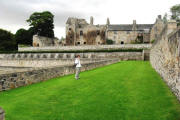
 |
Culross Abbey
In Culross, on the Firth of Forth
The remains of a Cistercian monastry founded in 1217. The eastern parts of the Abbey
Church are the present parish church. There are also ruins of he nave, cellars and other
domestic buildings.
Picture provided by Louise McGilviray. |
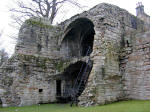 |
Dogton Stone
At Dogton farmhouse, one and a half miles east north east of Cardenden railway station, 58 NT 236 968
A much weathered free standing cross clab |
|
Dunfermline Palace and Abbey
In Dunfermline off the M90.
Tel: 01383 739026
The remains of a great Benedictine abbey founded by Queen Margaret in the 11th century.
The foundation of her church are under the present superb nave, built in the 12th century
in the Romanesque style. Robert the Bruce was buried in the choir, now the site of the
present parish church (closed during the winter). Substancial parts of the Abbey buildings
remain, including the vast refectory. Next to the Abbey is the ruin of the Royal Palace
rebuilt from the guest house of the monastry in the 16th century for James VI and his
Queen. This was the birthplace of Charles I, the last monarch born in Scotland.
Winter: closed Thursday afternoons and Fridays. |
 |
Inchcolm Abbey
On Inchcolm in the Firth of Forth. Reached by ferry from South Queensferry (30 minutes), Tel: 0131 331 4857 and from North
Queensferry (weather permitting), Tel: 0131 554 6881.
Known as the "Iona of the East". The abbey was founded in 1192 by Alexander I.
The island is also famed for its seals, wildlife and coastal defences from two world wars.
Winter: closed. |
 |
Ravenscraig Castle
On the eastern outskirts of Kirkcaldy, off Dysart Road
One of the earliest artillery forts in Scotland, begun for James II in 1460. It
consists of two round towers linked by a cross range. The west tower was the residence of
James II's widow, Queen Mary of Guelders.
Photo by Duncan Fenton |
 |
Rosyth
Castle
In Rosyth Dockyard, west of B981.
15th C keep, once standing on an island, now connected to mainland.Picture by Duncan
Fenton |
 |
St Andrews Castle
In St Andrews on the A91.
Tel: 01334 477196
The castle of the Archbishops of St Andrews dating in part from the 13th century. See the
fascinating mine and counter-mine - rare examples of medieval siege techniques - and the
bottle dungeon hollowed out of solid rock - from which death was the only release. The
seige works are the finest of their kind in Europe. A fascinating exhibition in the
visitor centre brings the history of the castle to life.
 |
 |
St Andrews Cathedral and Priory
In St Andrews on the A91.
Tel: 01334 472563
The remains still give a vivid impression of the scale of what was once the largest
cathedral in Scotland built in the 12th century. Climb St Rule's Tower for a magnificent
view of the town and visit the Cathedral's collection of Celtic and medieval carved
stones.
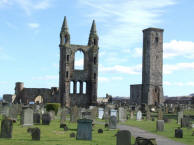
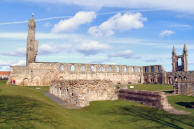 |

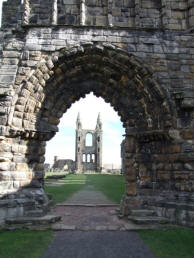 |
St Andrews: Blackfriars Chapel
In South Street, St Andrews
A vaulted side apse survives of this church of Dominican friars, which was rebuilt in
about 1516. |
|
St Andrews: St Mary's Church,
Kirkheugh
The scanty foundations of a small cruciform church on the edge of the cliff
behind the cathedral. It was the earliest collegiate church in Scotland. Destroyed in the
Reformation. |
|
St Andrews: West Port
In South Street
One of the few remaining city gates in Scotland, built in 1589 and renovated in 1843 |
|
St Bridget's Kirk, Dalgety
On the shores of the Forth, two miles south west of Aberdour, 66 NT 169 838
The shell of a medieval church, much altered in the 17th century for Protestant
worship. On the west end is a burial vault with laird's loft above, built for the Earl of
Dunfermline. |
|
Scotstarvit Tower
Three miles south of Cupar, 59 NO 370 112
Probably built in the 15th century, and remodelled between 1550 and 1579. Renowned as
the house of Sir John Scot, author of 'Scot of Scotstarvit's Staggering State of the Scots
Statesmen'. It is a particularly handsome and well-built tower. Keys are available from
Hill of Tarvit House.
Open Summer onlyPicture by Duncan
Fenton |
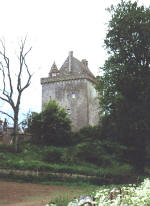 |
Dunfermline Abbey
Originally from 1150, has been rebuilt several times. Contains grave of
Robert The Bruce
Picture by Duncan
Fenton |
 |
Dunfermline Palace
Originally the guest house
of the Abbey, but altered in 16th C.
Picture by Duncan
Fenton |
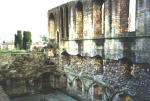 |
Leuchars Church
12th C. One of the best preserved examples of Norman architecture in
Scotland.
Picture by Duncan
Fenton |
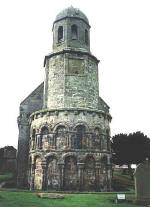 |

